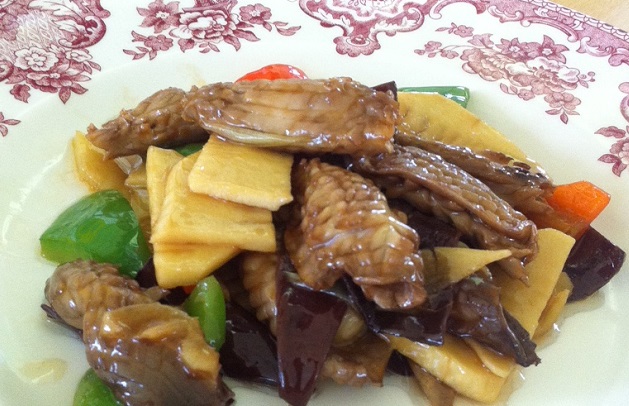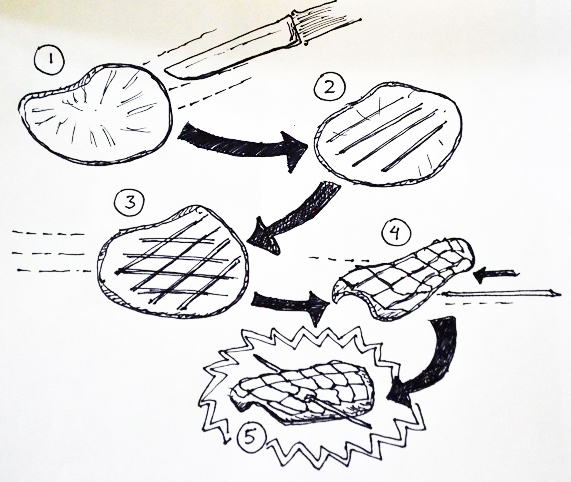Recipe from China: Huaiyang Vegetarian 'Kidney'

Huaiyang cooking is considered one of the four great traditions in Chinese cuisine, along with Cantonese, Shandong, and Sichuan. It represents regional dishes in the Huai’an, Yangzhou, and Zhenjiang areas of Jiangsu Province. Huaiyang dishes tend to be slightly sweeter, and almost never spicy; the cuisine is characterized by fine knife work and bright colors.
When cooking kidney, a diamond pattern is usually carved into the meat to make it prettier. The mushrooms in this dish imitate that pattern, and they have a similar texture. It is important to securely insert toothpicks into the mushrooms so that they will hold their shape while frying.
Ingredients
10 large oyster mushrooms
1 green bell pepper, sliced
1 red bell pepper, sliced
1 stalk of winter bamboo shoots, sliced (available at Asian markets)
2 oz cloud ear or wood ear, soaked (an edible black fungus, also available at Asian markets)
2 oz green onions, sliced
2 oz fresh ginger, sliced
Seasoning:
2 tsp oyster sauce (vegetarian versions are available)
Salt and sugar to taste
Preparation
- Slice stems from mushrooms and discard.
- Bring a pot of water to a boil. As it starts to boil, add mushrooms, and cook for 20 to 25 mins. Remove mushrooms and run under cold water.
- Flip over the mushroom tops so insides face up. Carefully score the surface of the mushrooms in lines without cutting through (see diagram). Rotate the mushrooms by 90 degrees and repeat scoring to form a diamond pattern.

- Roll mushrooms up with the diamond pattern on the outside. Secure with toothpicks.
- Heat oil in a wok. Add mushrooms to wok when the oil is hot and bubbling. Fry for 2 minutes. Drain mushrooms, remove toothpicks, and set aside.
- Drain off all but 1 tablespoon of oil from the wok. Add in ginger, green onions and seasoning.
- Add bell peppers, black fungus, and winter bamboo. Lastly, add in mushrooms. Stir-fry until vegetables are cooked through.
Karlie Leung was born and raised in Hong Kong and is currently a first-year graduate student at The George Washington University studying anthropology with a museum training concentration. She is an intern at the Center for Folklife and Cultural Heritage working with the China: Tradition and the Art of Living Folklife Festival program.

